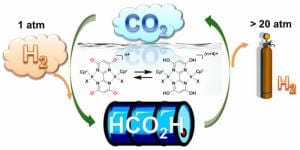
Sometimes, solutions for hard problems can turn out to be pretty basic.
That’s especially true for a team of researchers at the Office of Science’s Brookhaven National Laboratory (Brookhaven Lab), where the solution for a hard problem they were working on turned out to be pretty basic…and also a bit acidic.
The hard problem they were working on was how to store hydrogen fuel. Hydrogen gas (H2) is a clean and powerful fuel, but it’s also extremely light, which makes it difficult and costly to store. It’s typically held in high pressure tanks, although researchers at another Office of Science lab recently found a possible way to keep it in naturally-formed frozen cages.
In a paper published March 18th in Nature Chemistry, researchers at Brookhaven Lab led by chemist Etsuko Fujita announced that they had found a safe and reversible way to store hydrogen under mild (and therefore hopefully much more economical) conditions, using a newly developed catalyst.
Their work began by seeing acids and bases in an unconventional way — as potential carriers of hydrogen fuel. Students often learn about acids and bases as part of their science fair projects. The ‘volcanic’ reaction of vinegar (a mild acid) and baking soda (a mild base) has given many students an early interest in the sciences. That was true for Jonathan Hull, a lead researcher on the paper, who was intrigued by seeing a similar reaction blow the corks off wine bottles.
However, many acids and bases are actually watery solutions filled with hydrogen. In an acidic solution, the hydrogen atoms wander free. They’re usually missing their electron too, which gives them a positive charge (atoms and molecules with either a positive or a negative charge are called ions). In a basic solution, the hydrogen atoms are usually connected with something else, a negative ion of some sort. And yes, when an acid and a base react with each other, they typically create something neutral, like water.
The catalyst created by researchers at Brookhaven Lab connects hydrogen gas and carbon dioxide, “storing” the hydrogen linked to (adduct to) carbon dioxide in a mildly basic solution. The reaction can be reversed — and the hydrogen fuel released — by adding a bit of acid. The entire process can be run, and easily reversed, in a watery solution under mild temperatures and pressures with no toxic byproducts, and at a faster rate than any previous catalyst.
Read more . . .
Bookmark this page for “Solution for Hydrogen Storage” and check back regularly as these articles update on a very frequent basis. The view is set to “news”. Try clicking on “video” and “2” for more articles.







